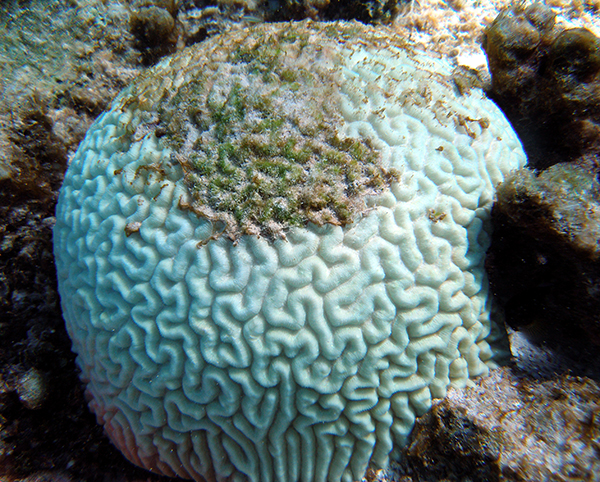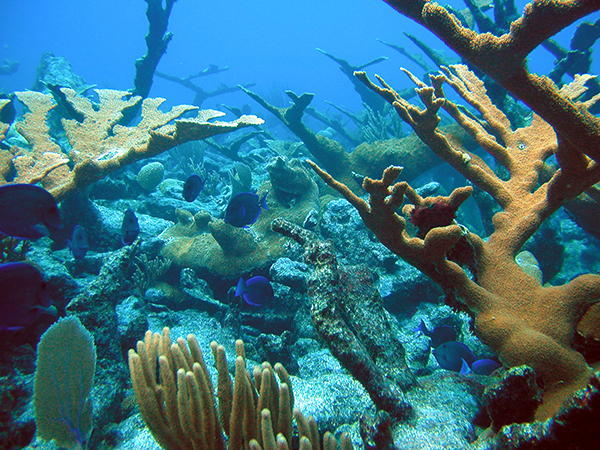
by Julie Freydlin Tuesday, November 12, 2013

Bleached brain coral. NOAA

A healthy coral reef in the U.S. Virgin Islands. NOAA
In the past few decades, corals around the world have become endangered because of rising water temperatures. However, a new study suggests that corals may be able to adapt to some of that warming.
Temperature records indicate that ocean waters started to warm shortly after industrial revolution, about the turn of the 20th century. In especially warm years, algae that inhabit corals — and supply them with food — start producing toxins. In an effort to protect themselves from the toxins, corals expel the algae, but as a result, lose their source of food. Left without nourishment, corals “are under more stress and are subject to mortality,” says Cheryl Logan, an assistant professor in the Division of Science and Environmental Policy at California State University at Monterey Bay and lead author of the new study in Global Change Biology. When temperatures become especially high, the loss of algae becomes noticeable as corals start turning white, a process known as bleaching. Widespread bleaching was observed for the first time in 1982 and was caused by a spike in average summer temperatures due to the El Niño cycle of that year, says Mark Eakin, one of the authors of the study and the director of the NOAA Coral Reef Watch monitoring program in College Park, Md.
Based on satellite data that first became available in the late 1980s, researchers know that corals in different parts of the world undergo bleaching — or exceed their “bleaching threshold” — at different temperatures. Corals in warmer locations around the world, for example, have higher bleaching thresholds than corals in cooler locations. But on average, corals everywhere bleach at about 1 to 2 degrees Celsius above the average temperatures for the warmest month of the year for a specific location. That threshold has not increased by much over the last few decades, as evidenced by the amount of coral bleaching that’s been observed around the world, Eakin says.
But, Eakin says, the fact that corals have different bleaching thresholds in different locations indicates that corals are capable of adapting their bleaching thresholds, so perhaps they can also adapt to rising temperatures within the same location.
To test this hypothesis, Logan, Eakin and their colleagues used the NOAA/GFDL Earth System Model 2. Based on water temperature records that were available in the beginning of last century, the team modeled what the bleaching threshold was for the years 1900 to 1910. If that threshold had remained constant, widespread bleaching events would have occurred prior to 1982 and would have been more intense, Eakin says. But globally such widespread bleaching wasn’t recorded prior to 1982, indicating that corals adapted to some of the warming that occurred, the team reported. Thus their research shows that corals can adapt, at least in part, they noted.
However, the adaptation — the increase in bleaching thresholds — is not keeping up with the rate of warming. “We are seeing an increase in the frequency and intensity of the warm events that are causing corals to bleach,” Eakin says. That is why so many corals can’t stave off bleaching in response to warming that is happening now.
The team attributes the corals’ ability to partially adapt to multiple factors. For one, when corals that are most sensitive to heat die, more resistant corals can repopulate vacated areas. In addition, corals are replacing ejected algae with algae that can better handle heat.
Based on these factors, the authors suggest that many corals might be able to survive through the end of the century — if the current rate of warming decreases. But other coral reef researchers say even if warming does decrease, corals are in trouble. “When I used an ensemble of climate models, I came to a different conclusion, " says Ruben van Hooidonk, a postdoctoral associate at the Cooperative Institute for Marine and Atmospheric Studies (CIMAS) at the University of Miami and NOAA's Atlantic Oceanographic and Meteorological Laboratory in Miami, who was not involved with the study. “I projected about 90 percent of reefs” will experience bleaching conditions annually by 2070, he says, even if warming does decrease.
One interesting note, Eakin says, is that although the adaptation may allow the corals to survive increasing temperatures, the adjustment carries negative side effects as well. When only heat-tolerant corals survive, biodiversity is lost. In addition, the heat-tolerant algae that replace the ejected algae grow more slowly, which means less food for corals. As a result, corals grow more slowly. In the meantime, carbon dioxide from the atmosphere is quick to react with the carbonate in the water to form carbonic acid, causing ocean acidification.
© 2008-2021. All rights reserved. Any copying, redistribution or retransmission of any of the contents of this service without the expressed written permission of the American Geosciences Institute is expressly prohibited. Click here for all copyright requests.